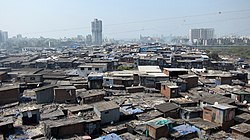
Back دهارافي Arabic Dharavi Czech Dharavi Danish Dharavi German Παραγκούπολη Νταράβι Greek Dharavi Spanish داراوی Persian Dharavi Finnish Dharavi French धारावी Hindi
Dharavi | |
|---|---|
 View of Dharavi | |
Dharavi, Mumbai, Maharashtra | |
| Coordinates: 19°02′16″N 72°51′13″E / 19.03778°N 72.85361°E[1] | |
| Country | |
| State | Maharashtra |
| District | Mumbai City |
| City | Mumbai |
| Founded | 1884 |
| Government | |
| • Type | Municipal corporation |
| • Body | Brihanmumbai Municipal Corporation (MCGM) |
| Area | |
| • Total | 2.39 km2 (0.92 sq mi) |
| Elevation | 20.47 m (67.16 ft) |
| Population (2016) | 700,000 to 1,000,000 |
| Language | |
| • Official | Marathi |
| Time zone | UTC+05:30 (IST) |
| PIN | 400017 |
| Telephone code | +9122 |
| Vehicle registration | MH-01 |
| Civic agency | BMC |

Dharavi is a residential area in Mumbai, Maharashtra, India. It has often been considered to be one of the world's largest slums.[1][2] Dharavi has an area of just over 2.39 square kilometres (0.92 sq mi; 590 acres)[3] and a population of about 1,000,000.[citation needed] With a population density of over 277,136/km2 (717,780/sq mi),[citation needed] Dharavi is one of the most densely populated areas in the world.
The Dharavi slum was founded in 1884 during the British colonial era, and grew because the expulsion of factories and residents from the peninsular city centre by the colonial government and from the migration of rural Indians into urban Mumbai. For this reason, Dharavi is currently a highly diverse settlement religiously and ethnically.[4]
Dharavi has an active informal economy in which numerous household enterprises employ many of the slum residents[5]—leather, textiles and pottery products are among the goods made inside Dharavi. The total annual turnover has been estimated at over US$1 billion.[6]
Dharavi has suffered from many epidemics and other disasters, including a widespread plague in 1896 which killed over half of the population of Bombay.[7] Sanitation in the slums remains poor.[8]
- ^ "Dharavi in Mumbai is no longer Asia's largest slum". The Times of India. 2011. Archived from the original on 11 November 2018. Retrieved 9 November 2018.
- ^ Arora, Payal (2019). The Next Billion Users: Digital Life Beyond the West. Cambridge, Massachusetts: Harvard University Press. p. 75. ISBN 9780674983786. OCLC 1057240289.
- ^ Ramanathan, Gayatri (6 July 2007). "Shanty-towns emerge targets for development". Livemint. Archived from the original on 19 January 2017. Retrieved 27 December 2016.
- ^ Sharma, Kalpana; Rediscovering Dharavi: Story From Asia's Largest Slum (2000) – Penguin Books ISBN 0-14-100023-6
- ^ Ahmed, Zubair (20 October 2008). "Indian slum hit by New York woes". BBC News. Archived from the original on 23 October 2008. Retrieved 1 May 2010.
- ^ "Jai Ho Dharavi". Nyenrode Business Universiteit. Archived from the original on 31 May 2009. Retrieved 5 March 2010.
- ^ Swaminathan, M. (1995). "Aspects of urban poverty in Bombay." Environment and Urbanization, 7(1), 133–144
- ^ The Bombay Slum Sanitation Program – Partnering with Slum Communities for SustainableSanitation in a Megalopolis (PDF). Washington: World bank. 1 September 2006. Archived (PDF) from the original on 15 August 2017. Retrieved 15 November 2018.
© MMXXIII Rich X Search. We shall prevail. All rights reserved. Rich X Search
